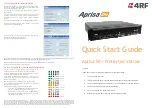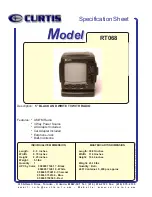
6 BK Radio
FEDERAL COMMUNICATIONS COMMISSION
REGULATIONS
The FCC rules require manufacturers to comply with the FCC RF
energy exposure limits for portable 2-way radios before they can be
marketed in the U.S. When 2-way radios are used as a consequence
of employment, the FCC requires users to be fully aware of and able to
control their exposure to meet occupational requirements. Exposure
awareness can be facilitated by the use of a product label directing
users to specific user awareness information. Your BK Radio 2-way
radio has a RF exposure product label. Also, your BK Radio owner’s
and service manuals include information and operating instructions
required to control your RF exposure and to satisfy compliance
requirements.
COMPLIANCE WITH RF EXPOSURE STANDARDS
Your BK Radio 2-way
radio is designed and tested to comply with a
number of national and international standards and guidelines (listed
below) for human exposure to radio frequency electromagnetic energy.
This radio complies with the
IEEE and ICNIRP exposure limits for
occupational/controlled RF exposure environment at operating duty
factors
of up to 50% transmitting and is authorized by the FCC for
occupational use only
.
In terms of measuring RF energy for
compliance with the FCC exposure guidelines, your radio radiates
measurable RF energy only while it is transmitting (during talking), not
when it is receiving (listening) or in Standby Mode. Note: The approved
batteries supplied with this radio are rated for a 5-5-90 duty factor (5%
talk-5% listen - 90% standby), even though this radio complies with the
FCC occupational RF exposure limits and may operate at duty factors
of up to 50% talk.
Your BK Radio 2-way radio complies with the following RF energy
exposure standards and guidelines:
•
United States Federal Communications Commission, Code of
Federal Regulations; 47 CFR §§ 1.1307, 1.1310, 2.1091 and
2.1093
•
American National Standards Institute (ANSI) / Institute of
Electrical and Electronic Engineers (IEEE) C95. 1-1992
•
Institute of Electrical and Electronic Engineers (IEEE) C95.1-
1999 Edition
INDUSTRY CANADA COMPLIANCE
This Class B digital apparatus complies with Canadian ICES-003. Cet
appareil numerique de la classe B est conforme à la norme NMB-003
Canada.
DPH-CMD Owner’s Manual 39
8. Long
[#]
keypresses will cause the second
line of the display to cycle through the
data blocks that can be transferred to the
target radio.
Target Valid
Data
DPHCMD
GROUP 00 or GROUP 01 – 25
CMND GRP
PICK LISTS
9.
Once the data to be transferred has been
selected, press the
[FCN]
key on the
Master radio keypad. The top line of the
display will flash ‘
CLONING
’ while the
program in the master is being
downloaded to the clone.
10.
If the download was successful, the
display on the Master will again display
the clone prompt (target and data to be
transferred)
.
• To clone another channel group,
press the Master radio’s
[CLR]
key.
Navigate to a ‘
CH
’ prompt, then press
and hold the
[#]
key to get the ‘
GRP
’
prompt. Select ‘
GRP 0’
to clone
global settings.
•
If cloning is finished, turn off the Clone
and disconnect the cloning cable.
Normal radio operation will occur
when you turn on the Clone.
11. If the download was not successful, the
master will flash ‘
FAILURE
’ and multiple
beeps will follow. Failure of downloading
can be due to:
• Improper
connection
•
Failure to turn on the clone
• Setting the clone in Programming
Mode
•
Target radio’s group ‘locked’ by PC
Programming.
CLONING
CLONING
CLONING
CLONING
Group 01
FAILURE
FAILURE
FAILURE
FAILURE
Group 01
PROG|DPHcmD
Cmnd group
Cmnd group
Cmnd group
Cmnd group
PROG|DPHcmD
pick list
pick list
pick list
pick listSSSS
Содержание DPH- CMD
Страница 22: ...DPH CMD Owner s Manual 43 NOTES ...
Страница 23: ......






































